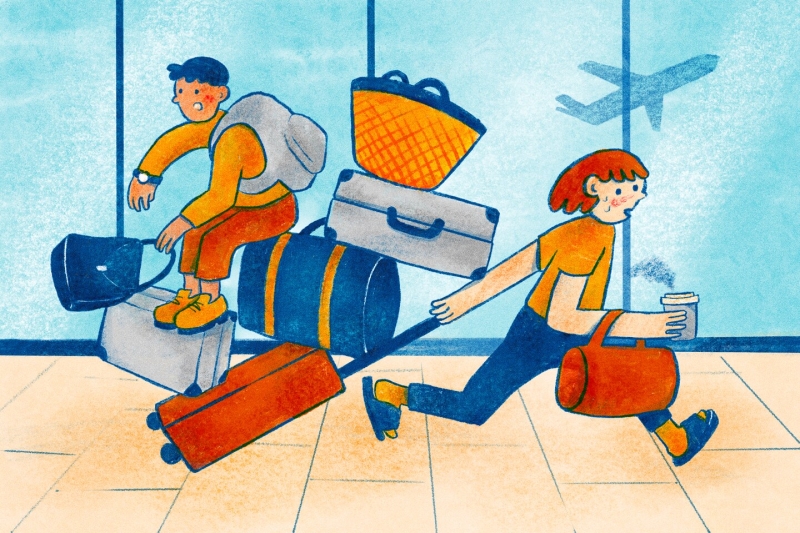Contents
How to pull off a short flight connection, and when to give yourself more time.
Sorry, a summary is not available for this article at this time. Please try again later.

By Natalie B. Compton
If you’ve ever shopped for airfare without a direct option, you’ve probably come across the connecting flight conundrum.
Do you roll the dice with the shortest layover possible? Or play it safe with more airport downtime? Can you trust whatever options your airline offers?
Some travelers make calculated decisions on their connections based on data, weighing an airline’s on-time statistics against airport terminal maps. Others make their own rules, like John Rose, chief risk and security officer of the travel agency Altour, who’s flown more than 3.5 million miles.
“I won’t do 90 minutes or less,” he said of his layover strategy. “I’m not a run-through-the-airport person.”
But that doesn’t mean a layover less than 90 minutes is doomed.
“Airlines add a lot of padding to their flight times,” said Scott Keyes, founder of the cheap-flights booking site Going. “By adding in that extra 30 minutes, if they push from the gate a few minutes late, if there’s some bad weather and they have to circle a bit, it still looks like it’s an on-time flight rather than a delayed flight.”
Not only does it help an airline’s on-time performance look better on paper, it means there’s some buffer in your schedule.
Does that mean you can always pick an airline’s closest call? Not quite. Here’s how to decide how much buffer time you need between flights in the United States.
When an hour layover could work
For domestic travel, “you can usually get by with a 30 [or] 40 minute connection,” Keyes said. “As long as your first flight is on time, you should be able to make the second flight just fine.”
Shorter connection times have a better shot if your next leg is taking off from the same part of the airport as your inbound flight, or if you’re passing through a smaller airport. They may have just enough time to power walk from one plane to the next, not stopping for food or bathroom breaks.
Experts say airlines won’t give you a short layover option unless they think you can actually make it; after all, it’s the airlines that set minimum connection times (a term they shorten to MCT), and they’re on the hook for rebooking you if you miss it. Airlines have the data to see how many people missed connecting flights, and they have calculated departure times accordingly.
“When an airline makes a decision to connect you with a flight that has a 45-minute connection, it probably has you in the same concourse, or a concourse over,” Steve Mayers, the former director of customer experience at Hartsfield-Jackson Atlanta International Airport, previously told The Washington Post. “It knows that you will have enough time to get to your gate.”
Even if the airline is confident you’ll make a short connection, booking anything under an hour comes with risks. Even moderate delays — from bad weather, staffing issues or maintenance problems — could throw your travel day out of whack.
When in doubt, take two hours between flights
Choosing a longer layover factors in some room for error, or having to hop on a train to get to another terminal, or dealing with fellow travelers who dawdle while disembarking from your first flight.
If you have time-sensitive plans, like arriving on the day of your best friend’s wedding or embarking on a cruise, book a flight with at least two hours of time to make up for delays or canceled flights.
You’ll also want a safer buffer (at least two hours) if you’ve booked a “hacker fare” — when you fly with one carrier for the first leg of your trip, then switch to another for the second leg. That second airline will not rebook you or hold the plane if your first flight runs late.
Lean more cautious if you’re booking a connection if there won’t be many options for rebooking if disaster strikes. For example, if you’re flying with a smaller airline with a limited number of flights, missing one may mean having to wait a week to catch the next or missing your trip completely.
Rose has the same concern during busy travel periods (summer break, winter holidays). When planes are full and weather is unpredictable, it can be harder to find you a replacement flight.
“You could end up being delayed a day,” he said.
Add more time for assistance and luggage
As airports and airlines deal with a record number of travelers but struggle with staffing, people who have special needs or require wheelchair services don’t have the luxury of cutting connection times close. Delays while waiting for wheelchairs after flights are common.
Call your airline well in advance of your flight to request wheelchair service, but know there’s still a chance you may have to face delays. To be safe, plan three hours for your connection.
Keyes added that travelers checking bags should opt for longer layovers. “When you have a tight connection, your checked luggage might not make it onto the plane even if you do,” he said. “It’s not as though it’s necessarily lost permanently, but you do have a higher likelihood of a lost, misplaced [or] delayed bag.”
Caveats for international travel
Everything changes when you’re traveling internationally. Keyes said this is when you want the largest buffer between flights, at least two hours if not more.
Remember that for most flights coming to the United States from abroad, you have to pass through Customs and Border Protection (CBP) and another security checkpoint after landing, plus recheck any luggage, before you head to your next flight.
You can speed up that customs process with the Mobile Passport Control app or enrolling in Global Entry. But don’t rely on the potential of a shorter line. Line-cutting services available to you once might not be in place the next time.
And all bets are off when you’re traveling overseas, where every airport and airline has its own set of rules. Research layover protocols thoroughly before booking your connecting flights abroad to make sure you get where you need to go smoothly — or at least smoother.
More on air travel
Leave flying to the pros: Think you could land a plane in an emergency? Experts say you’re wrong. Here’s what you should actually do if something goes awry during a flight.
Pet peeves: Why do “gate lice” line up early for a flight? Psychologists explained for us. Another move that annoys airline workers: abusing the flight attendant call button. For more on how to behave on a flight, check out our 52 definitive rules of flying.
Plane mess: Stories about extremely disgusting airplanes have been grossing out travelers. The question of plane cleanups became the subject of a recent debate after a flight attendant allegedly told a pregnant passenger to pick up the popcorn spilled by her toddler.
Frequent flying: Airline status isn’t what it used to be, but at least there are some good movies and TV shows to watch in the air. And somewhere out there, experts are trying to make airline food taste good.

